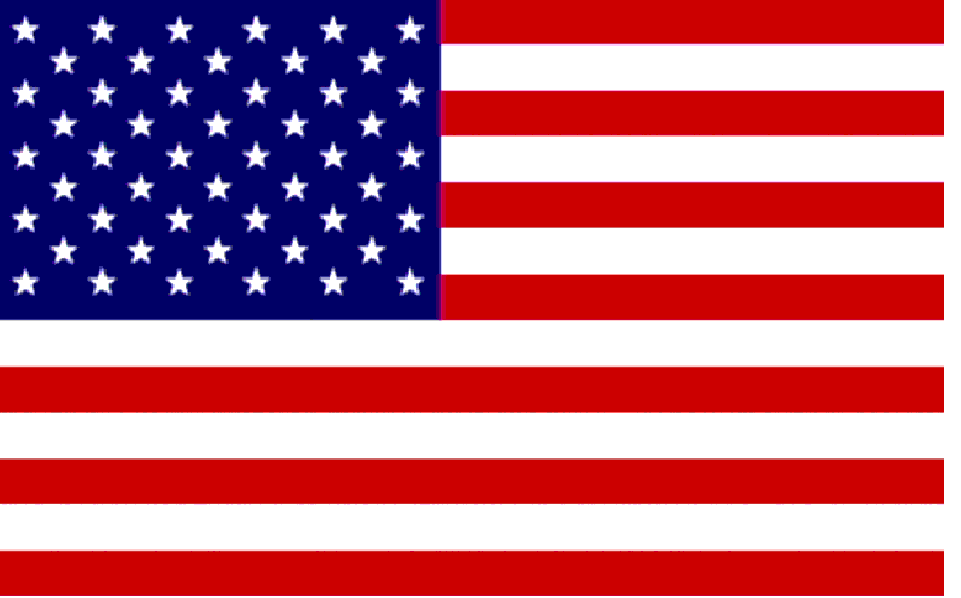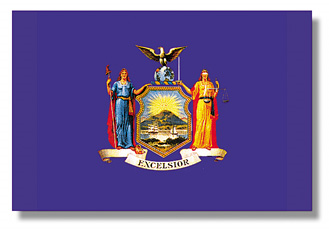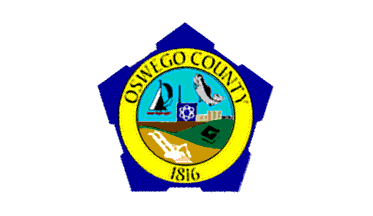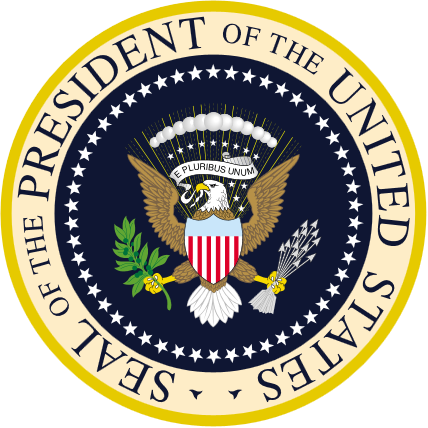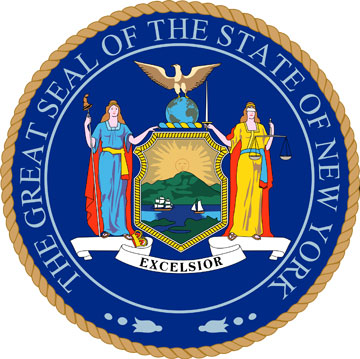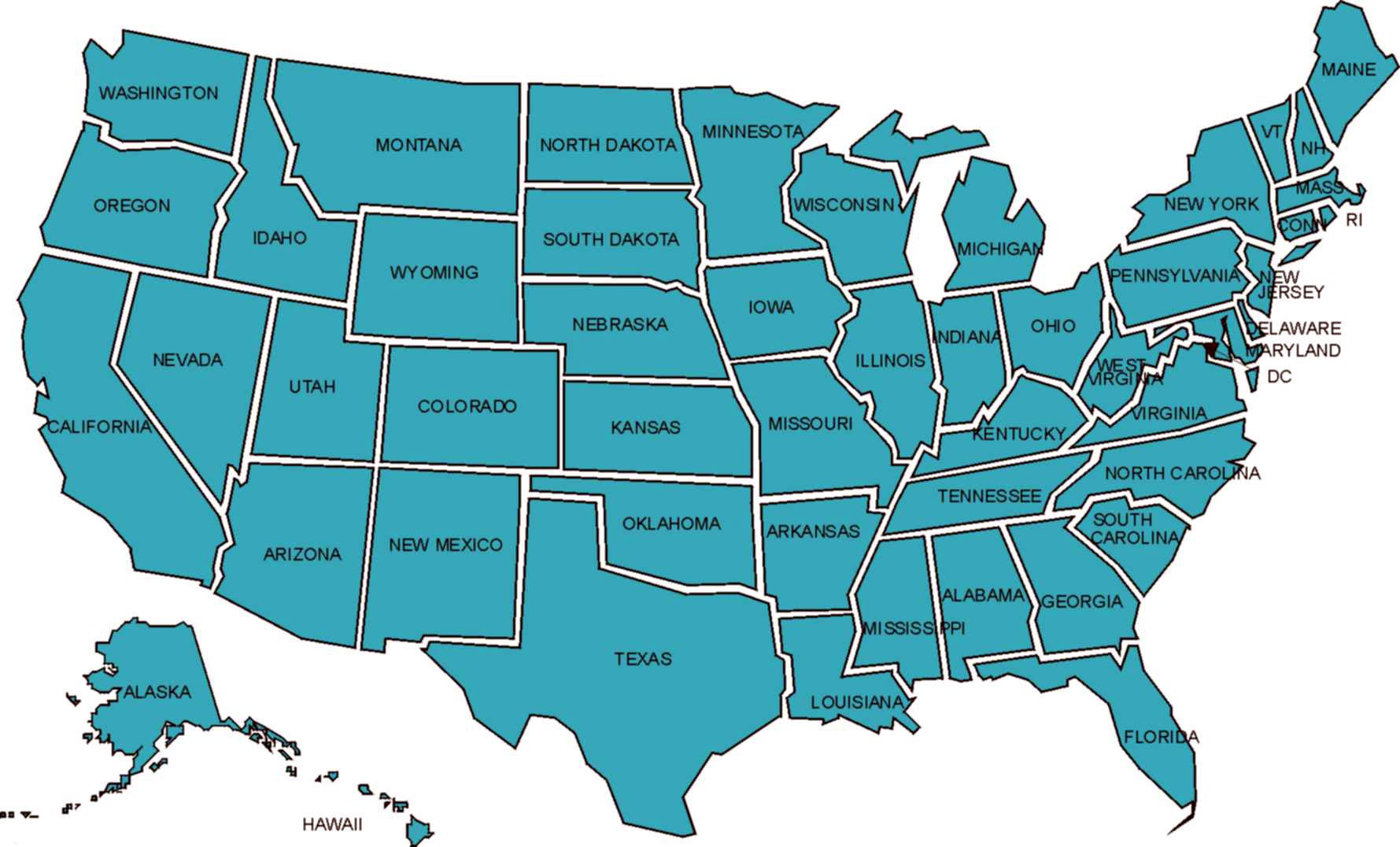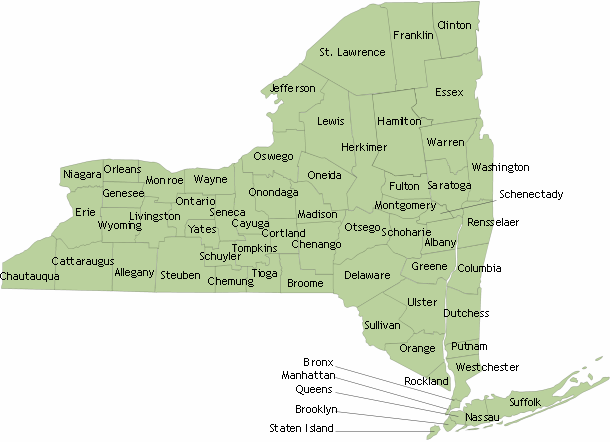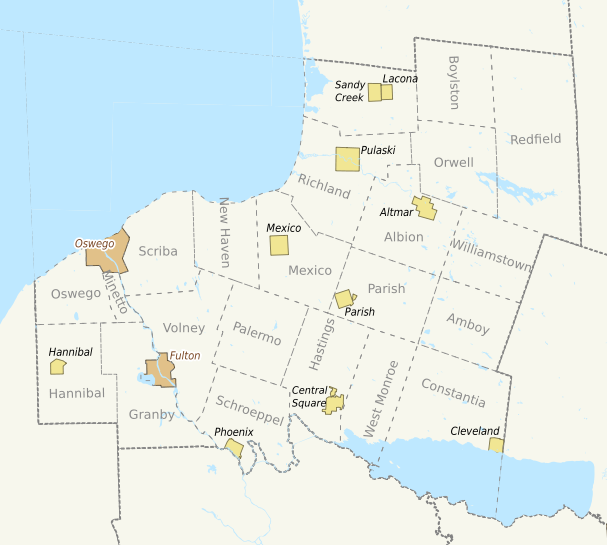Federal Functions
United States Government
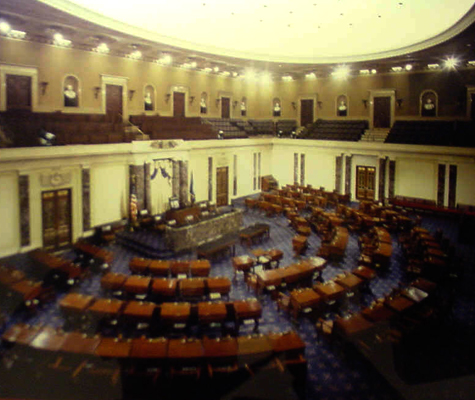
The United States Senate chamber in Washington D.C.
The federal government of the United States was created by the Constitution, which went into operation in 1789 when the first Congress convened and George Washington took the oath of office as president. The government is called federal because it was formed by a compact (the Constitution) among 13 political units (the states). These states agreed to give up part of their independence, or sovereignty, in order to form a central authority and submit themselves to it. Thus, what was essentially a group of 13 separate countries under the Articles of Confederation united to form one nation under the Constitution.
When the Declaration of Independence was issued in 1776, it used the term United States of America. Until the Constitution was adopted and ratified, however, the 13 states did not really form one nation. They each held onto so many powers individually, including conducting foreign policy and trade negotiations, that the Continental Congress could only do what the states allowed. The Articles were never the law of the land to the extent that the Constitution is. In essence, the United States as a nation did not come into existence until the Constitution began to function as the framework of the government.
Once the Constitution was in place, tension between the states and the federal government did not automatically cease. Many political thinkers believed that the states were really the supreme authority.
According to this viewpoint, states could nullify acts of the federal government that were disagreeable to them. One of the strongest proponents of this view was John C. Calhoun, senator from South Carolina. His chief opponent was Chief Justice John Marshall. Calhoun's position, called states' rights, has persisted to the present. It was seriously undermined, however, by the American Civil War. Since that war the federal government has gained much power at the expense of the states.
Objects of Government
John Adams, in an article published in 1818, redefined the American Revolution: "The radical change in the principles, opinions, sentiments, and affections of the people was the real American Revolution." He saw the revolution carried out in the determination of the former colonists to establish a constitution as a charter of liberty and freedom, with limits to its authority.
The Preamble to the Constitution lists six purposes for which the new government of the United States of America was established. These purposes, in general, are to form a more perfect union, establish justice, insure domestic tranquility, provide for the common defense, promote the general welfare, and secure the blessings of liberty.
In composing the Preamble the framers of the Constitution were making a statement unprecedented in the history of governments. In the past, apart from Great Britain, governments were not in the habit of issuing lists of objectives--they simply governed. And government was usually an exercise of power over subjects, not citizens. The wording of the Preamble asserts that the people--not the states--are creating the government and are granting it certain powers for fixed purposes.
Two of these purposes are common to all governments: the police power (domestic tranquility) and defense against outside enemies. The other objectives arose from the political thought of the Enlightenment and from the experience of the United States in its relations with Britain.
The goal of union stemmed in part from the failure of the Articles of Confederation. The insistence on justice and liberty was in part a reaction against the injustices perpetrated by king and Parliament prior to the American Revolution.
The general welfare phrase was new and provided a source of controversy. Like the other objectives, its purpose was to serve the common good, but its meaning has always been subject to dispute.
No sooner was the Constitution ratified than James Madison and Thomas Jefferson began to disagree with Alexander Hamilton on the meaning of the term general welfare in both the Preamble and in Article 1, section 8. For Madison and Jefferson the term was a fairly empty one, referring to all the powers listed in section 8. To Hamilton it seemed an open invitation to unlimited governmental authority, since almost anything the government wanted to do could be categorized as belonging to the general welfare.
It is not likely that the phrase promote the general welfare was intended to refer either to limited or unlimited powers of government. If the phrase is to make sense, it must have a significance of its own on a level with the other five objectives. It is probable that its meaning was best stated by Abraham Lincoln in his "Fragment on Government" in 1854: "The legitimate object of government is to do for a community of people whatever they need to have done, but cannot do at all, or cannot so well do for themselves in their separate capacities." There are many things that government can more easily do than individuals or groups. Among them are building roads and highways, canals, airports, and port facilities. Supporting public schools is another.
While the Preamble is remarkable for what it says, it is more so for what it fails to say. There is no reference in it to government operation of the economy. For the first time in history this was specifically excluded as a government function. Government stood aside from direct provision of the basic human needs of food, clothing, and shelter as well as from all other forms of production. By the late 20th century this situation had changed markedly, with the establishment of a welfare state and a vast involvement by the federal government in economic functions.
Separation of Powers
It has proved true, historically, that there is a natural tendency of governments to assume as much power as possible. To prevent this from happening in the United States, the framers of the Constitution divided the functions of the federal government among three branches: the lawmaking branch, the executive branch, and the judiciary. This separation of powers is in direct contrast to the government in Britain. There Parliament is the single governing unit. Members of the executive--the Cabinet and the prime minister--are members of Parliament. The highest court of appeal is the House of Lords
The separation of powers was also in contrast to the government under the Articles of Confederation. The Articles provided for no separate executive branch. The president was the presiding officer of the Congress. There was no national court system at all.
The framers of the Constitution decided on a government in which the three main functions would be held by three separate branches. The Congress was empowered to make laws. The president was empowered, through the departments and agencies of the executive branch, to enforce the laws. The president is thus the head of the bureaucracy--the non-elected officials of government. The Supreme Court was established as the highest judicial authority. This three-part arrangement was referred to by John Adams as a system of checks and balances.
In addition to distributing power among the three branches of the federal government, the Constitution also distributes it among the states and the people. The Tenth Amendment specifically reserves all "powers not delegated to the United States" to the "States respectively, or to the people." Within each state there are many other governmental units. Each local government, from the smallest village to the largest city, has its necessary powers. There are taxing bodies, such as school districts, that have the authority they need in order to operate.
Congress: The Legislative Branch
One of the most difficult debates in the Constitutional Convention of 1787 centered on representation. The large states desired representation in proportion to population in the proposed national legislature. This would, of course, have allowed them to control legislation because they would have had more legislators than small states. The small states, conversely, wanted equal representation. On June 11, 1787, delegate Roger Sherman of Connecticut proposed the plan that was eventually adopted. It called for a bicameral, or two-house, legislature in which one house has proportional representation and the other equal representation. Thus the small states were placated by having equal representation and the large states with proportional representation. After much wrangling among the delegates, the plan was adopted on July 16.
The Congress was created by Article I, section 1, of the Constitution: "All legislative powers herein shall be vested in a Congress of the United States, which shall consist of a Senate and House of Representatives." The first Congress was due to meet in New York City on March 4, 1789, but bad weather and worse roads delayed the members. By April 6, enough Congressmen had assembled to begin preliminary business. The Senate had only 20 members, since two states had not yet ratified the Constitution, and New York did not elect its senators until the following July. The House membership was also short--it had only 59 members.
Until the adoption of the 20th Amendment in 1933, members of Congress took office on March 4 in the year following their election. They did not meet in session, however, until the following December--more than a year after the election--unless the president called a special session. It thus became possible for a session meeting from December 3 of an even-numbered year until the next March 4 to be controlled by "lame ducks"--members who had been defeated in the previous election. To eliminate this situation the 20th Amendment was adopted. Members of Congress now take office on January 3 in the year following an election. Congressional terms extend from each odd-numbered year to the next odd-numbered year because elections are held in November of even-numbered years. Dates of adjournment are voted by the membership.
At the beginning of a regular session, the president delivers a State of the Union address to a joint session of Congress. In years when there is an outgoing president and an elected president waiting to be sworn in, two such addresses are possible. Congress must also convene in special session every four years in December to count the electoral votes naming the new president. Joint sessions are also held when the president or a foreign dignitary addresses both houses. Joint sessions are not legislative sessions.
Enacting laws does not consume most of the time of members of Congress. Most of the work of the two houses is done in committees. There are 16 standing committees in the Senate and 22 in the House. There are also subcommittees, special committees, congressional commissions, and joint congressional commissions. Each house may appoint special investigating committees such as those that conducted hearings on the Watergate scandal in 1973-74 and the Iran-contra affair in 1987.
The committee systems of Congress developed largely by accident, and many committees created for specific purposes outlived their usefulness. In 1921 the Senate reorganized its committee structure and greatly reduced their number. The House did the same in 1927. Committees of each house are controlled by the political party that has a majority of members in that house. Appointments to committees are mostly based on seniority. The ranking, or most senior, member normally becomes chairman.
In addition to its committee and lawmaking activities, Congress also exercises a general legal control over all government employees. It may also exercise political control through the Senate's power of approving presidential nominations. Congress cannot remove officials from office except by its power of impeachment. In an impeachment proceeding the House acts as a grand jury, gathering evidence and securing an indictment. The Senate then becomes the court in which the case is tried. There has only been one complete presidential impeachment proceeding in American history--that of Andrew Johnson--and he was acquitted. A bill of impeachment was voted against Richard M. Nixon, but he resigned before a Senate trial could begin.
Among Congress' non-legislative powers is that of initiating amendments to the Constitution, though the states also have this power. Congress may determine whether the states should vote on amendments by special conventions, which is how the Constitution was ratified, or through their legislatures.
In matters of legislation, all bills and joint resolutions must be passed in identical form by both houses and signed by the president. The exception is an amendment to the Constitution, which is not signed by him. Should the president veto a bill, it may be enacted over his veto by a two-thirds vote of both houses. Failure to repass in either house kills it. If a bill is not signed or returned by the president, it becomes law after ten working days. If the president does not return a bill and Congress has adjourned in the meantime, however, the bill does not become law. This procedure is called a pocket veto
Bills introduced in either house are first sent to the committee having jurisdiction over them. A committee can kill a bill, bury it, or amend it. If the bill is reported favorably out of committee, it is sent to the floor of the respective house for debate and passage--with or without amendments. A bill passed by one house is sent to the other for consideration. There it may be passed intact, it may be amended and passed, or it may be defeated. If one house does not accept the version of a bill passed by the other house, the bill is sent to a conference committee composed of members of both houses. After final passage the bill is signed by the speaker of the House and the vice-president (who is the presiding officer of the Senate) and sent to the president for his signature.
The powers of Congress are specified in Article I, section 8, of the Constitution. Chief among them is the power to assess and collect taxes, for it is this authority that makes running the whole government, including the other two branches, possible. The power to decide how to spend money lies in both houses, but only the House of Representatives has the authority to originate bills for raising revenue.
Each house, because it is the judge of the "qualifications of its own members," may punish its members for misbehavior. Members can be expelled by a two-thirds vote. Actions of certain members have occasionally resulted in some form of rebuke. Senator Joseph R. McCarthy of Wisconsin was censured on Dec. 2, 1954. Representative Adam Clayton Powell of New York was excluded from the 90th Congress by a House vote in 1967.
The proceedings of the Congress are published daily in the Congressional Record. Publication of this journal began on March 4, 1873. The Record is a generally accurate account of daily proceedings, but the speeches of house members may be heavily edited for readers. Occasionally speeches included in the Record were never actually delivered on the floor of either house but are inserted to impress voters in home districts.
House of Representatives
The House of Representatives was intended by the framers of the Constitution to reflect the popular will. Its members therefore are directly elected by the people. The number of representatives from each state is proportional to the size of the state's population. No state, however, has less than one representative. Representation is reapportioned after every census. After the states receive their quota of seats, the states themselves determine the boundaries of the congressional districts. In 1964 the Supreme Court ruled that population sizes within each district must be approximately equal. The special powers of the House are two: the right to originate revenue bills and the right to begin impeachment proceedings.
By the time it adjourned the first House had 65 members. Today the House has 435 members, a number reached in 1912. This number was made official in a law of 1941. Two representatives were added when Alaska and Hawaii became states, but the number was returned to 435 after the next census. House members must be 25 years of age, be citizens of the United States for at least seven years, and must reside in the state that is represented. The whole membership of the House stands for election every two years.
Other members of the House are a resident commissioner from Puerto Rico and delegates from American Samoa, Guam, the Virgin Islands of the United States, and the District of Columbia. These individuals may take part in floor debates, but they have no vote.
The Constitution does not specify the organization of the House other than to stipulate the selection of a speaker and other officers. As presently organized, the House has kept some ancient parliamentary offices, including the speaker, clerk, sergeant at arms, and doorkeeper. Two other officers are the postmaster and the chaplain. The speaker of the House presides over its sessions. He is a member of the majority party controlling the House at a given session and is elected by his fellow party members. He is therefore his party's leader in the House.
Each party has a House leader--the majority leader and the minority leader--and under these are the majority whip and minority whip. The whips, as their name implies, try to keep party members in line for crucial votes. The committee chairmen also have party influence. The central unit of a party in the House is the conference, or caucus. Its purpose is to develop the basic party organization that is responsible for carrying on the work of the House. Party control of the membership has declined, and considerable latitude is allowed members of both parties.
The clerk is the chief administrative officer of the House, responsible for keeping its journal, taking votes, certifying passage of bills, and processing legislation. The clerk prepares the House budget and disburses funds.
Senate
The makeup and general rules for the "world's most exclusive club," as it is often called, are detailed in Article I, section 3, of the Constitution. The Senate has 100 members, two for each state. Since 1913, when the 17th Amendment was ratified, senators have been directly elected by the people. Prior to that year they were elected by state legislatures. When vacancies occur between elections, state governors appoint replacements.
The Senate has some special powers not accorded to the House. It approves or disapproves of presidential appointments; it can approve treaties, by a two-thirds vote; and it is the court for impeachment trials.
To become a senator an individual must be at least 30 years of age, a citizen of the United States for nine years, and a resident of the state from which elected. The full term of a senator is six years. The terms of one third of the members expire every two years.
The presiding officer of the Senate is the vice-president of the United States. It is the only duty for that official prescribed by the Constitution. In his absence the presiding officer is the president pro tempore, meaning "for the time being," who is elected by the membership. As in the House, there is a majority leader and a minority leader. The Senate majority leader is often a powerful figure in government, especially if the president is of the other party.
The functions of the secretary of the Senate are similar to those of the House clerk. The chief executive officer of the Senate is the sergeant at arms, who supervises all departments and is, as well, the chief law enforcement officer. Duties include rounding up absent senators when a quorum is needed and when votes are being taken and conducting many ceremonial functions, including escorting the president for addresses to joint sessions of Congress.
The Senate, in its floor debates, has more freedom of action than does the House. As a rule, debate on a measure continues until every senator has had a chance to say everything he wishes on it. Freedom of debate is occasionally abused by a filibuster, a device by which a senator can talk endlessly to prevent a bill from coming to a vote. Senate rules provide for stopping a filibuster by the application of cloture, or closing debate, which requires the support of two thirds of the members present and voting. The cloture rule was adopted in 1917.
Agencies of Congress
The common interests of both houses are served by a number of agencies responsible to Congress or to joint committees of Congress. These agencies are the Architect of the Capitol, the United States Botanic Garden, the General Accounting Office, the Government Printing Office, the Library of Congress, the Office of Technology Assessment, the Congressional Budget Office, and the Copyright Royalty Tribunal.
The Architect of the Capitol is an office created in 1793 to oversee the construction of the Capitol Building. Today the agency is charged with the care and maintenance of the Capitol and grounds, which include 208.7 acres (84.5 hectares) of landscaping, parks, streets, and parking spaces. The office is also responsible for the structural care of the Library of Congress and the Supreme Court Building in addition to a variety of other duties.
The United States Botanic Garden was founded in 1820 but did not remain in continuous operation. It was revived in 1842, when the government had to find space to accommodate collections brought to Washington, D.C., from the South Seas by the United States Exploring Expedition led by Captain Charles Wilkes. The Botanic Garden is under the direction of the Joint Committee of the Library. Annual appropriations for it are provided by Congress.
The General Accounting Office (GAO) was established in 1921 to provide independent audits of government agencies. The GAO also assists Congress by providing information on all matters of pending legislation. It assists members of Congress in investigations and studies. Under the leadership of the comptroller general, the GAO has the authority to verify energy-related information for Congress. Its auditing authority extends to all departments of government. The GAO provides legal services and makes final determination on the legality of actions taken in the spending of federal funds. It also settles claims against the United States and collects debts.
The Government Printing Office (GPO) is one of the world's largest publishers. It was established in June 1860 to print documents for Congress and all departments of the federal government. The GPO also sells thousands of publications to the public.
The Library of Congress, established in 1800 as a research facility for Congress, is today one of the world's largest libraries. In addition to its huge collection of books, the library is also responsible for copyrights. The library operates an extension service through its interlibrary loan system and numerous other services. The American Folklife Center, founded in 1976, is part of the library.
The Office of Technology Assessment was created in 1972 as another research facility to serve Congress. The primary task of the office is to identify the effects of technology on society.
The Congressional Budget Office was established in 1974 as an agency to help Congress oversee the federal budget process, aid in fiscal policy, review tax policies, and study the allocation of federal funds. It performs economic analysis by studying the effects of federal spending on the national economy and by projecting cost estimates of legislation passed by Congress.
The Copyright Royalty Tribunal, established in 1976, sets royalty rates for transmission and other use of copyrighted materials. These include books, records, and cable television programs.
Excecutive Branch
Just as the delegates to the Constitutional Convention had differences over the nature of Congress, so too were there sharp disagreements on the nature of the Executive Office. Should there be one president or three? Should he serve for life or for a limited term? Was he eligible for reelection? Should he be elected by the people, by the governors of the states, or by Congress?
The outcome of the debates was Article II of the Constitution, outlining the office of the president. The presidency would consist of one individual holding office for four years but eligible for reelection. Because the delegates did not trust the people to elect a president directly, they established an indirect method. Electors chosen by state legislatures (and eventually by the voters) voted for candidates for the presidency. To be eligible for the presidency a person must be a native-born citizen, 35 years of age, and must have lived in the United States for at least 14 years.
Based on the example set by George Washington, successive presidents did not seek more than a second term until Franklin D. Roosevelt ran for office and was elected four times, beginning in 1932. The 22nd Amendment, ratified in 1951, limits the term of office for presidents.
The Constitution gives many specific powers to the president. Other powers have accrued to the office through laws passed by Congress, through interpretations of laws by the courts, and through the president's position as leader of his party.
The president is charged with enforcing all federal laws and with supervising all federal administrative agencies. In practice these powers are delegated to subordinates. The president's principal helpers include the White House staff, specialized agencies of the Executive Office, and the heads of executive departments and their agencies and bureaus. Except for the White House staff, the individuals in charge of agencies and departments are appointed by the president, subject to approval by the Senate. The president nominates all officials, administrative or judicial, who are not civil-service employees.
The Constitution gives the president the power to grant reprieves and pardons to persons convicted of crimes against the United States. This power is denied only in the case of an individual convicted on impeachment.
The president exercises far-reaching powers in the conduct of foreign policy. In most cases he acts through the secretary of state and the Department of State. The president negotiates treaties, mostly through subordinates. These are subject to confirmation by a two-thirds vote in the Senate. He nominates ambassadors, ministers, and consuls to represent the United States abroad. He takes the lead in recognizing new regimes or withholding official recognition.
Closely related to his foreign policy authority is the president's role as commander in chief of all the armed forces. He appoints all commissioned officers of the Army, Navy, Air Force, and Marines. During wartime he may become involved in planning strategy.
Proper functioning of the government depends in great measure on the president's relations with Congress. It is his responsibility to keep Congress informed of the need for new legislation. He must also submit an annual budget for all the government expenditures. The departments and agencies are required to send Congress periodic reports of their activities, and members of departments and agencies are often required to testify before committees of Congress on matters of pending legislation or other issues.
In times of war or other national crisis, Congress usually grants the president emergency powers. These powers include the authority to issue orders regulating most phases of national life and the war effort, to organize special agencies of government, and to make appointments without confirmation.
In normal times, as well as during emergencies, Congress may pass laws establishing a policy but leaving the details to be worked out by the Executive Office. The president then publishes an executive order that has the force of law.
The only official duty of the vice-president is to preside over the Senate, though he does not take part in its deliberations. He casts a deciding vote in case of a tie. In the president's absence he presides over meetings of the Cabinet (see Cabinet Government). Originally there were no candidates for this office. The man receiving the second-largest number of votes for president became vice-president. In 1801 Thomas Jefferson and Aaron Burr each received 73 electoral votes, and the House of Representatives had to decide between the two candidates. After 36 ballots Jefferson became president and Burr vice-president. As the party system developed, separate candidates were nominated for each office on the same ticket.
Party politics in the 20th century has dictated that the vice-president be a consistent supporter of presidential policies no matter what his personal opinions. This was not always true a century earlier. Political tensions between North and South frequently divided parties. John C. Calhoun, vice-president to Andrew Jackson, resigned in 1832 in a dispute with Jackson.
Since the time of President Harry S. Truman, there has been an attempt to involve vice-presidents in the activities of the Executive Office by granting them membership on the National Security Council and in performing other tasks. Article II of the Constitution provides for the succession of the vice-president to the presidency in case of the death, resignation, or removal of the president. The 25th Amendment, ratified in 1967, provides that he also serve as acting president if the president is temporarily incapacitated.
Divisions of the Excecutive Branch
Congress functions primarily in Washington, D.C. The executive branch of government operates throughout the United States and its possessions and in all foreign nations with which the United States has diplomatic relations. Immediately subject to the president is the White House Office. Also closely associated with him is the Executive Office of the President, which includes several agencies transferred to the office by the Reorganization Act of 1939 and subsequent legislation. Next are the 14 departments: Agriculture, Commerce, Defense, Education, Energy, Health and Human Services, Housing and Urban Development, Interior, Justice, Labor, State, Transportation, Treasury, and Veterans Affairs. Next are a large number of independent commissions, boards, corporations, and agencies. Among them are the Securities and Exchange Commission, the Federal Trade Commission, the General Services Administration, and the Federal Home Loan Bank Board.
The White House Office consisted of about 85 individuals in the late 1980s. These people, headed by the chief of staff, are the president's personal advisers on all matters of policy, including relations with Congress and the media. These advisers are hired by the executive branch and are not subject to approval by the Senate.
The Executive Office consists of agencies that deal in foreign and domestic policy for the president. Heads of these agencies are nominated by him, subject to confirmation by the Senate. These agencies are the Office of Management and Budget, the Council of Economic Advisers, the National Security Council, the Office of Policy Development, the Office of the United States Trade Representative, the Council on Environmental Quality, the Office of Science and Technology Policy, the Office of Administration, and the Office of the Vice-President. The secretaries of the departments make up the president's Cabinet.
Departments of Congress
Each federal department is headed by a secretary, who has several specialized undersecretaries responsible to him. These officials are nominated by the president subject to confirmation by the Senate.
The Department of State
was established in 1789 and is therefore the oldest and highest ranking Cabinet office. It is headed by the secretary of state, who acts on behalf of the president in relations between the United States and foreign governments. With its many field agents in the Foreign Service, the department is a vital link between the United States and other countries. It is also a valuable source of information for the president in foreign policy decisions. The department speaks for the United States in the United Nations through the United States Mission to the United Nations.
The secretary of state
is assisted by a deputy secretary and undersecretaries of state for political affairs, economic affairs, security assistance, and management. The department has five regional bureaus: African Affairs, European and Canadian Affairs, East Asian and Pacific Affairs, Inter-American Affairs, and Near Eastern and South Asian Affairs. The other 11 bureaus are Economic and Business Affairs, Intelligence and Research, International Organization, Legal Adviser, Public Affairs, Consular Affairs, Politico-Military Affairs, Oceans and International Environmental and Scientific Affairs, Protocol, Human Rights and Humanitarian Affairs, and the Bureau for Refugee Programs.
The Department of the Treasury,
established in 1789, is the second-ranking executive department. The Treasury is the custodian and manager of the public purse. It collects taxes, duties, and other revenues. It borrows money for the government on short-term notes and long-term bonds. It is responsible for management of the debt. It disburses federal funds. It controls the coinage and making of paper money, enforces revenue laws, and makes reports on the nation's finances.
Agencies with the Treasury are the Bureau of Alcohol, Tobacco, and Firearms; the Office of the Comptroller of the Currency; the United States Customs Service; the Bureau of Engraving and Printing; the Federal Law Enforcement Training Center; the Financial Management Service; the Internal Revenue Service; the United States Mint; the Bureau of the Public Debt; the United States Savings Bond Division; and the United States Secret Service. Members of the Secret Service are assigned to protect the president and his family, former presidents and their families, and the vice-president and his family.
The Department of Defense
was established in 1949 to integrate the policies and procedures for all agencies relating to defense. Its three major components are the departments of the Army, Navy, and Air Force.
Earlier the military forces of the United States had been represented by the Department of War, established in 1789, and the Department of the Navy, created in 1798. Each had been headed by a secretary with Cabinet rank. The Defense Department is now headed by a civilian secretary of defense, who has direction and control of the service branches. Each service has a secretary without Cabinet rank. Next in command are the Joint Chiefs of Staff, representing the armed forces. In terms of personnel, the Defense Department is the largest government agency, as it includes all members of the armed forces.
The Armed Forces Policy Council advises the secretary of defense on policy matters. The council is made up of the deputy secretary of defense; the secretaries of the Army, Navy, and Air Force; the undersecretaries of defense for policy and for research and engineering; the chairman of the Joint Chiefs of Staff; the chiefs of the Army and the Air Force; the chief of naval operations; and the commandant of the Marine Corps.
The Department of Justice
was established in 1870. It provides the means for enforcement of federal laws, furnishes legal counsel in federal cases, affords legal opinions to the president and heads of departments, and directs federal prisons. The head of the department is the attorney general, a Cabinet member since 1789.
The deputy attorney general
coordinates the operation of the department and supervises the federal district attorneys and marshals. Presidential appointments of federal judges, attorneys, and marshals clear through the deputy attorney general.
The solicitor general
represents the government in cases before the Supreme Court and in any other court if the attorney general thinks it advisable. Each type of case is handled by a division headed by an assistant attorney general. The divisions are: Antitrust, Civil, Civil Rights, Criminal, Land and Natural Resources, and Tax. The assistant attorney general for legislative affairs is the chief liaison officer with Congress.
Bureaus within the Justice Department are: the Federal Bureau of Investigation, the Bureau of Prisons, the United States Marshals Service, the International Criminal Police Organization-United States National Central Bureau, the Immigration and Naturalization Service, the Drug Enforcement Administration, and the Justice Assistance Act Agencies. The Justice Assistance Act of 1984 established programs of financial and technical assistance to the states and local governments. The new agencies created under the act are: the Office of Justice Programs, the Bureau of Justice Assistance, the National Institute of Justice, the Bureau of Justice Statistics, and the Office of Juvenile Justice and Delinquency Prevention. Boards within the
Justice Department are:
the Executive Office for Immigration Review, the United States Parole Commission, the Foreign Claims Settlement Commission of the United States, and the National Drug Policy Board.
The Department of the Interior
was established in 1849. Since its inception the department has served two contrasting purposes. During the westward movement of the frontier, it freely granted the resources of the nation to individuals and groups to hasten the growth of the United States. At the time unoccupied land, minerals, timber, and wildlife were abundant and were regarded as expendable.
Today the department's functions are the opposite. It is the government's chief conservation agency. Minerals, public lands, waterpower, fish, wildlife, scenic wonders, and recreation areas are all under the custodianship of the department for the benefit of the American people.
The department is headed by the secretary of the interior. There is an undersecretary, along with assistant secretaries for fish and wildlife and parks; water and science; land and minerals management; Indian affairs; policy, budget, and administration; and territorial and international affairs.
Bureaus within the department are: the United States Fish and Wildlife Service, the National Park Service, the Bureau of Mines, the Geological Survey, the Office of Surface Mining Reclamation and Enforcement, the Bureau of Indian Affairs (originally part of the War Department, 1824-49), Minerals Management Service, the Bureau of Land Management, and the Bureau of Reclamation.
The Department of Agriculture
was established in 1862. Until 1889 it was administered by a commissioner of agriculture. The divisions of the department are: Small Community and Rural Development, Marketing and Inspection Services, Food and Consumer Services, International Affairs and Commodity Programs, Science and Education, Natural Resources and Environment, and Economics.
The Small Community and Rural Development division
includes the Farmers Home Administration, the Rural Electrification Administration, and the Federal Crop Insurance Corporation. The Marketing and Inspection Services include the Agricultural Cooperative Service, the Agricultural Marketing Service, the Animal and Plant Health Inspection Service, the Federal Grain Inspection Service, the Food Safety and Inspection Service, the Office of Transportation, and the Packers and Stockyards Administration.
Food and Consumer services
is divided into the Food and Nutrition Service, the Human Nutrition Information Service, and the Office of the Consumer Advisor. The International Affairs and Commodity Programs comprises the Agricultural Stabilization and Conservation Service, the Commodity Credit Corporation, the Foreign Agricultural Service, and the Office of International Cooperation and Development.
The Science and Education
division includes the Agricultural Research Service, the Cooperative State Research Service, the Extension Service, the National Agricultural Library, and the Office of Grants and Programs Systems. The Natural Resources and Environment division includes the Forest Service and the Soil Conservation Service. Included in the Economics division is the Economic Research Service, the National Agricultural Statistics Service, the Economic Analysis Staff, the Office of Energy, the World Agricultural Outlook Board, and the Economics Management Staff.
A Department of Commerce was proposed by Gouverneur Morris in 1787, as the Constitution was being debated. It did not become a reality until 1903, when it was established as the Department of Commerce and Labor. In 1913 the Department of Labor became independent.
The Department of Commerce
fosters the nation's business, trade, and industry. It grants patents, conducts environmental research, provides weather forecasts, takes censuses, maintains measurement standards, and performs numerous other tasks related to its basic functions. Its divisions are: the National Technical Information Service, the Bureau of the Census, the Bureau of Economic Analysis, the Economic Development Administration, the International Trade Administration, the Minority Business Development Agency, the National Bureau of Standards, the National Oceanic and Atmospheric Administration, the National Telecommunications and Information Administration, the Patent and Trademark Office, and the United States Travel and Tourism Administration.
The Department of Labor,
established as a separate division in 1913, had the distinction of having as secretary of labor the first woman to achieve Cabinet rank--Frances Perkins. She held office from 1933 until 1945. The largest division within the department is the Employment and Training Administration. It has within it the Office of Employment Security, the Unemployment Insurance program, the Employment Service, the Office of Trade Adjustment Assistance, the Office of Job Training Programs, the Senior Community Service Employment Program, the Apprenticeship and Training programs, the Office of Strategic Planning and Policy Development, the Office of Financial and Administrative Management, and the Office of Regional Management. The other divisions are: the Office of Labor-Management Standards, the Office of Pension and Welfare Benefits Administration, the Bureau of Labor-Management Relations and Cooperative Programs, the Employee Standards Administration, the Occupational Safety and Health Administration, the Mine Safety and Health Administration, the Bureau of Labor Statistics, and the Veterans' Employment and Training Service.
The Department of Health and Human Services (HHS)
was, until 1953, the Federal Security Agency. It was then renamed the Department of Health, Education, and Welfare (HEW) and raised to Cabinet status. Its current name was adopted in 1980, when the responsibility for education was transferred to a new department. The HHS promotes social and economic security, national health, and child welfare. The programs administered under HHS by the Social Security Administration are retirement and survivors insurance; disability insurance; and supplemental security income for the aged, blind, and disabled.
Additional divisions of HHS are: the Office of Human Development Services, the Public Health Service, the Health Care Financing Administration, and the Family Support Administration, which helps carry out the federal-state program of Aid to Families with Dependent Children (AFDC).
The Department of Housing and Urban Development (HUD)
was established in 1965 to oversee programs that provide federal-funded housing assistance. The department's program areas are: Community Planning and Development, Fair Housing and Equal Opportunity, Housing, Public and Indian Housing, the Government National Mortgage Association, and the Office of Policy Development and Research.
The Department of Transportation (DOT)
was created in 1966 to promote transportation safety, develop a national transportation policy, and prepare guidelines for federal spending for facilities and equipment. Its divisions are: the Federal Aviation Administration, the Federal Highway Administration, the Federal Railroad Administration, the National Highway Traffic Safety Administration, the Urban Mass Transportation Administration, the Maritime Administration, the St. Lawrence Seaway Development Corporation, the Research and Special Programs Administration, and the United States Coast Guard.
The Department of Energy (DOE)
was established in 1977 to provide the framework for a comprehensive, balanced national energy policy. Its divisions include: the Energy Information Administration, the Economic Regulatory Commission, and the Federal Energy Regulatory Commission.
The Department of Education
was established in 1980 to coordinate more than 150 federal programs, ranging from college loans to telecommunications. The department absorbed several functions that had belonged to HEW. It has offices of Bilingual Education and Minority Languages, Civil Rights, Elementary and Secondary Education, Educational Research and Improvement, Vocational and Adult Education, Special Education and Rehabilitative Services, and Postsecondary Education. The department also supplies funds to the American Printing House for the Blind, at Louisville, Ky.; Gallaudet University and Howard University, both at Washington, D.C.; and the National Technical Institute for the Deaf, Rochester Institute of Technology, at Rochester, N.Y.
The Department of Veterans Affairs (VA)
assumed the responsibilities of the Veterans Administration in 1989. The independent agency that had been established in 1930 became the 14th Cabinet department. Among the veterans' benefits it handles are pensions, loans, vocational rehabilitation and education, insurance, and the nation's largest medical-care system.
Author: William Kehen, PhD. Columbia University -1996
http://history-world.org/united_states_government.htm

